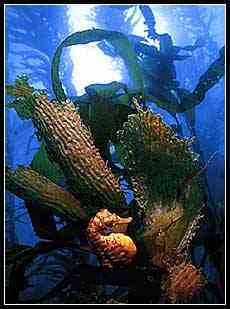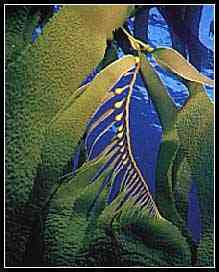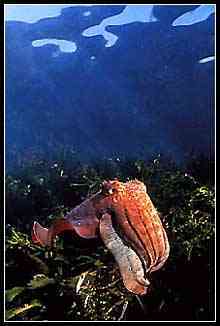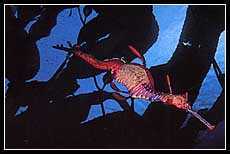Kelp Forests

Big-Bellied Seahorse (Jon Bryan)
Like huge fingers that disappear into the depths of the sea, the Giant Kelp Forests found in the waters off Tasmania and Victoria, are the rainforests of the sea.
Try swimming 20 metres straight down and you will still not reach their roots. On the way down see if you can spot a leafy sea dragon that hides by looking like a floating piece of torn off kelp. Watch out for huge king crabs that roam through the forest or sea snails that crawl up and down the kelp's long leaves.
Big-Bellied Seahorse (Jon Bryan)
Did you know that....?
- Kelp leaves called fronds can grow up to 50 centimetres a day.
- Kelp forms dense canopies up to 35 metres above the seabed.
- Most of us eat kelp regularly, by consuming ice-cream or jelly. Products made from kelp are used to thicken these foods, and other products like toothpaste. In Australia, giant kelp is harvested from the beaches of King Island in Bass Strait.
Giant Kelp (Jon Bryan)
What lives here?In crevices and under boulders: Abalone and spiny urchins hide during the day and come out at night to feed on tiny algae that they scrape off the rock.
High and low in the canopy: Meat and plant eating creatures such as sea snails, octopus, cuttlefish, seahorses and finned fish move through the canopy in search of a snack. Huge king crabs with huge claws also roam about this leafy domain.
Climbing up the kelp: Brightly coloured sea stars and soft spined urchins make their home among the kelp fronds.
Around other plants and animals: A wealth of microbes, including bacteria, single celled algae and worms live here. While small in size, they are vital to keeping the kelp ecosystem healthy.
Giant Cuttlefish (JonBryan)
Do whales drop-in?
Orca pods swim near kelp forests surrounding offshore islands in search of seals to eat. Orcas (otherwise known as Killer Whales) are often seen off Tasmania.
Dr B. Diversity TellsTwo species of kelp make up the giant kelp forests in Tasmania and Victoria. Their scientific names are Macrocystis pyrifera (found in south, east and western Tasmania) and Macrocystis angustifolia (found in northern Tasmania and Victoria).
The giant kelp M. pyrifera is one of the longest and fastest growing marine plants in the world. Kelp forests are important marine habitats and provide shelter for large populations of fish, crustaceans, sea-snails, sea-stars and sea-urchins.
Little is known about how all the animals and plants of the giant kelp forests relate to each other. Scientists think that the upper canopy provides homes and nurseries for many species of fish and invertebrates (animals without a backbone), including lobsters and abalone.
Weedy Seadragon (William Boyle)
Here in the year 2050?The size and number of giant kelp beds in Tasmania has greatly fallen over the last 30 years. Only about five per cent of the original area remains, and the kelp forests are threatened with local extinction in some areas. Scientists think that a number of factors may be causing this decline:
- Over-harvesting in some areas
- The fall of dissolved nutrient levels in the ocean waters of Tasmania
- The increase in water temperature off eastern Tasmania: a rise of 1.5°C since the 1960s.
To make sure that the giant kelp forests stay around into the next century, they need to be protected in marine national parks and reserves, and the threats affecting them need to be stopped.




